How To Take 10000 Steps A Day And What Are The Results Of It?
If you have been wondering whether or not to put on your walking shoes, here are some clues.

Image: Shutterstock
10,000 steps a day can keep the doctor away! If you walk 1.5 miles or 2.4 km, you can take 10,000 steps, which will contribute to better health and a happy heart. There are many studies that prove that a minimum of 10,000 steps a day can help in weight loss, improve cardiovascular fitness, reduce high blood pressure, and help attain better mental health (1), (2), (3).
Not sure how you can start walking 10,000 steps a day? We can help. Here’s everything you need to learn about taking 10,000 steps a day, benefits, and useful tips on how to fulfill your fitness goal when the gyms are closed due to COVID-19. Scroll down to check them out!
 Workout Blueprint: 10,000 Steps A Day
Workout Blueprint: 10,000 Steps A Day- Frequency: Daily
- Benefits: Aid in weight loss, improve cardiovascular fitness, and reduce blood pressure.
- Equipment Needed: Fitness tracker, walking shoes.
- Space Required: Large space
- Assistance Required: No
- Who Should Avoid: Anyone with a foot injury or joint strain.
In This Article
How To Take 10,000 Steps A Day
Maintaining an active lifestyle is the key to achieving physical and mental health, and incorporating a daily routine of 10,000 steps is a great way to start. The Heart Foundation recommends practicing moderate-intensity activities (including brisk walking) for at least 2.5 hours every week (4). This physical activity can help improve your overall health.
Ariel, a YouTuber, spoke about her experience of walking 10,000 steps every day for a month in her vlog. She said, “I lost 3 pounds. My pudding has shrunk (i).”
A survey was conducted on about 156 million citizens, aged 16 or more, by the American Community Survey. They found that about 2.6 % or 4 million walked to work as compared to 5% of workers who used public transportations services in 2019.
The American Academy Of Orthopedic Surgeons states that although the average human walks 2500-5000 steps a day, adding more steps can provide benefits, such as increased oxygen intake, reduced stress, and toned muscles, among others (5).
You will be surprised to know how easily you can take 10,000 steps a day! Here are the most effective ways you can do it:
1. Buy A Pedometer

A pedometer counts the number of steps you take. It helps you in goal setting, and you can also use the step counter in your fitness band, watch, or smartphone. The pedometer will give you an accurate measure of how many steps you are yet to take to reach your target of 10,000 steps a day. Monitoring the steps taken will also help you set a mental goal, which will motivate you to get up and start walking.
 Trivia
Trivia2. Take The Stairs
Take the stairs instead of the elevator. It is a great calorie burner, works on your quads, hamstrings, and glutes, improves heart health, and, of course, will help you reach the target of 10,000 steps a day. However, if you have a knee injury or are recovering from surgery, avoid taking the stairs.
3. Walk To Nearby Places
Instead of taking the car or bike, walk to nearby places. Quick, short walks will also help you get the time to think, reflect, enjoy nature, make new friends (maybe), and release serotonin (the feel-good hormone). You will burn calories and de-stress. Isn’t that a good deal?
 Quick Tip
Quick Tip4. Walk Around Every Hour
Sitting at one place for too long not only causes pot belly but also leads to poor posture and mental fatigue. Take a break every hour. Walk around and get at least 50 steps. It will help break the monotony, keep your metabolism going, and help you get a new perspective on what you are working on.
5. Walk Your Dog

Walking the dog is a great exercise for you as well. Take your dog out for walks twice a day. You may walk or jog. You can also play with your dog. This will help increase your heart rate, release feel-good hormones, and burn some serious calories.
6. Play With Kids
Playing with kids in the park can help you get closer to your 10,000 steps a day, for sure! Running around will help improve your stamina and endurance and reduce stress levels. Also, spending time with your kid(s) will help you bond as a family, make memories, and share stories.
7. Park Far Away
Parking away from the elevator will make you walk an extra 50-100 steps. If you take public transport, get down one or two stops before and walk to your destination from there.
8. Walk Swiftly
Walk swiftly if you also wish to lose weight or get rid of belly fat. A faster-paced walk will help burn fat, increase heart rate, and improve endurance and stamina. Wear walking shoes and workout clothes and carry a water bottle with you.
9. Keep A Journal
Maintain a journal to track your progress from Day 1. If you are not used to walking, start with 100 steps on the first day. Keep adding 300 steps every day. Track your progress. Also, write about how you feel and what you did to walk the extra 300 steps that day. When you reach the target of 10,000 steps, you will be surprised at how your determination and adherence to the plan made you successful.
10. Reward Yourself

Reward yourself when you first reach the 10,000 steps. Do not go overboard and consume too many calories or stop walking! Celebrate your success by buying another workout gear or plan a cheat meal sometime next week.
These are the 10 ways you can take 10,000 steps a day. But how many calories will you burn? Find out below.
Key Takeaways
- The easiest way to take 10,000 steps a day is to be more active (like taking the stairs).
- Depending on a few factors like intensity and age, you can burn close to 400-500 calories by taking 10,000 steps a day.
- If you are quarantined at home, you can try a few simple exercises – like spot dancing – to reach this count.
- This will help you stay in shape, feel more energetic and positive, and even improve your skin health.
How Many Calories Do 10,000 Steps A Day Burn?
Taking 10,000 steps a day may help you burn 400-500 calories a day. However, that will depend on the intensity, time duration, age, sex, current weight, medical history, and current medication.
The next question is how to take 10,000 steps during the coronavirus pandemic? The gyms are closed, and you are quarantined. Here’s what you can do.
How To Still Get 10,000 Steps A Day During The COVID-19 Pandemic

Staying active not only supports physical health but also acts as a powerful tool for mental well-being. It proved especially helpful during the challenging COVID-19 pandemic time. Regular exercise stimulates the release of endorphins, which are natural mood elevators that can help reduce anxiety and depression (6).
You can enhance your overall mental health and better navigate the challenges of isolation and uncertainty by adding exercise to your daily routine.
With all the gyms and community parks closed, it is tough to walk 10,000 steps a day. But you can keep yourself active even in quarantine. Here are a few effective ways:
- Treadmill – If you have a treadmill, make the best use of it now. Walk on a 3-degree incline. You may also jog, run, or do sprints. Wear running shoes. Do not try to get to 10,000 steps in a day or run at 14 mph on the first day. Increase the pace and steps gradually. If you do not own a treadmill, do the following exercises:
- Dance – Dancing is a fun workout session. It will help you burn 300-400 calories, improve fitness, balance, and flexibility, and elevate your mood.
- Spot Jogging – Jogging at one place is known as spot jogging. Jog at one place for 1-2 minutes. Rest for 10 seconds and jog again for 1-2 minutes. You will burn 100 calories if you do it for 10 minutes.
- Jumping Jacks – Do 30 jumping jacks and rest for 10 seconds. Do 30 more. Ten minutes of jumping jacks will burn about approx 80-100 calories.
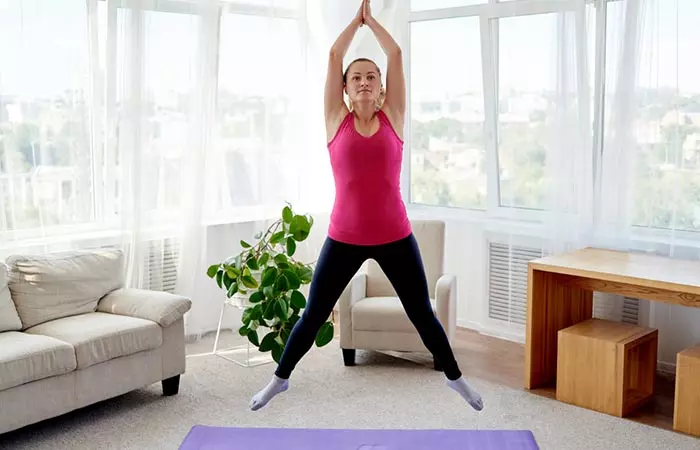
- Jumping Rope – The rope jump is a great warm-up exercise and full-body workout. You will burn 100-200 calories, depending on the reps and intensity. Do high-intensity rope jumps to lose fat.
- Squat Jumps – Adding a jump to squats can make it a functional exercise. These are similar to box jumps. Here’s how to jump squats. You will burn calories and improve balance, fitness, and lower body tone.
- High Knees – This exercise is similar to spot jogging. Only, this time, you have to raise your knees higher. It is a high-intensity exercise that targets the core and lower body muscles and helps shed fat from the overall body. Do 3 sets of 25 reps to burn about 100 calories.
- Other Exercises – The main aim is to stay physically active while staying indoors. Apart from the exercises mentioned above, you can do HIIT, yoga, bodyweight exercises, hula hoop exercise, and stretch.
What will happen after a week of taking 10,000 steps or doing these indoor exercises? Find out next.
Results After A Week
Do these exercises for 5 hours a week, and you will lose weight, stay in shape, feel energetic and motivated, and see an improvement in mood. As you will sweat, it will also help flush out toxins and improve your skin health.
If you are wondering what benefits you can reap by walking 10,000 steps daily, then scroll down to the next section!
Benefits Of Walking 10,000 Steps Per Day
There are numerous benefits of walking as it is considered a one-stop solution to manage hypertension and heart ailments. Walking 10,000 steps a day is an achievable and effective way to improve your physical and mental well-being. Some advantages include:
- May Improve Cardiovascular Health: Regular walking may reduce the risk of heart disease, and blood pressure and improve cholesterol levels (7), (8).
- Helps In Weight Management: Walking burns calories, which may help with weight loss (9).
- Boosts Joint Health: It is a low-impact exercise that supports joint mobility and reduces the risk of osteoarthritis (10), (11).
- May Improve Mental Health: Walking may reduce stress and anxiety while boosting mood and mental clarity (9).
- May Aid Better Sleep: It may improve sleep quality and help with insomnia (12).
- May Enhance Immunity: Regular walkers are said to experience fewer sick days as walking strengthens the immune system (13).
- May Boost Digestive Health: Walking may promote better digestion, thus alleviating constipation (14).
Infographic: 5 Effective Ways To Take 10,000 Steps A Day
An active lifestyle is the key to good health and a happy heart. Walking 10,000 steps a day is a step closer to this goal. It might seem like a difficult feat, but it is not impossible. We are here to help you achieve 10,000 steps a day in some of the most effective ways. Check out the infographic below to learn them!
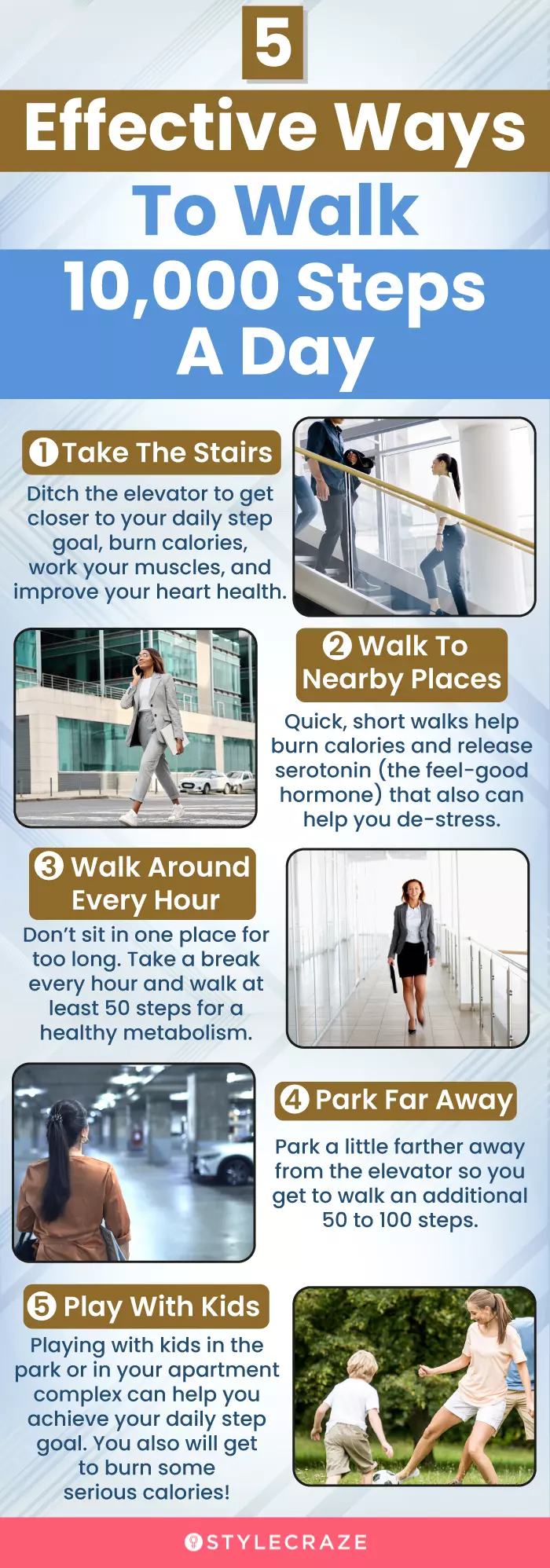
Illustration: StyleCraze Design Team
With a sedentary lifestyle and hectic work schedules, keeping yourself active might seem a challenge. However, when you can’t find the time to stick to any detailed workout routine, just taking 10,000 steps a day during your work calls or meetings, can help boost your overall health and immunity. It not only helps keep chronic aches and pains at bay, but also stretches and strengthens your muscles to keep you fit and agile. Make an effort to squeeze in those 10,000 steps in your daily schedule and feel the difference for yourself.
Frequently Asked Questions
Will walking 10000 steps a day tone my legs?
Yes, walking 10000 steps a day can help tone muscles all over the body, including the legs.
Can you walk 10000 steps in 30 minutes?
Yes, you can. But, it depends on your intensity and speed. You can reach 10000 steps in 30 minutes if you walk fast, spot jog, or power walk.
Is it better to walk or run?
Walking is less intense than running, but running can cause more injuries. You can also try a combination of the two, which is common in HIIT.
Does walking tone your arms?
Yes, walking can tone the muscles in your arms. It helps if you move your arms back and forth while walking.
How many steps are in 60 minutes of walking?
This depends on your walking intensity, if you take breaks, your height, your age, and if you have any medical conditions.
Do steps count as cardio?
Yes, walking is considered a low or moderate cardio workout. This can be a good addition to your workout along with other cardio exercises at home, such as jumping jacks, spots jogs, etc.
What are the maximum steps in a day?
This depends on your age, height, walking intensity, and health condition, but the average number of steps per day varies between 5000-18000 steps per day.
Illustration: How To Take 10000 Steps A Day And What Are The Results Of It?

Image: Stable Diffusion/StyleCraze Design Team
Find out what an expert has to say about walking 10,000 steps a day. Click on the video below to get your facts right and plan your fitness journey in the most effective ways.
Personal Experience: Source
StyleCraze's articles are interwoven with authentic personal narratives that provide depth and resonance to our content. Below are the sources of the personal accounts referenced in this article.
i. I Walked 10,000 Steps Every Day for a Month Without Dieting | Before and After Results | Weight losshttps://www.youtube.com/watch?v=BnuJoy_Pww0
References
Articles on StyleCraze are backed by verified information from peer-reviewed and academic research papers, reputed organizations, research institutions, and medical associations to ensure accuracy and relevance. Read our editorial policy to learn more.
- Yuenyongchaiwat Kornanong. “Effects of 10000 steps a day on physical and mental health in overweight participants in a community setting: a preliminary study.” Brazilian journal of physical therapy vol. 204 (2016): 367-73.
https://pubmed.ncbi.nlm.nih.gov/27556393/ - Increasing walking steps daily can reduce blood pressure and diabetes in overweight participants Diabetology International 9(1): 75-79.
https://www.ncbi.nlm.nih.gov/pmc/articles/PMC6224870/ - Hallam K T et al. “”Happy feet”: evaluating the benefits of a 100-day 10000 step challenge on mental health and wellbeing.” BMC psychiatry vol. 181 19.
https://pubmed.ncbi.nlm.nih.gov/29361921/ - Physical Activity
https://www.heartfoundation.org.nz/wellbeing/being-active/physical-activity - Exercise Walking
https://orthoinfo.aaos.org/en/staying-healthy/exercise-walking/ - The impact of exercise on depression: how moving makes your brain and body feel better
https://pmc.ncbi.nlm.nih.gov/articles/PMC11298280/#:~:text - Walking – the first steps in cardiovascular disease prevention
https://www.ncbi.nlm.nih.gov/pmc/articles/PMC3098122/ - Walking vs running for hypertension cholesterol & diabetes risk reduction
https://www.ncbi.nlm.nih.gov/pmc/articles/PMC4067492/ - Exercise for Mental Health
https://www.ncbi.nlm.nih.gov/pmc/articles/PMC1470658/ - Regular walking exercise prior to knee osteoarthritis reduces joint pain in an animal model
https://pubmed.ncbi.nlm.nih.gov/37561757/ - Walking and Other Common Physical Activities Among Adults with Arthritis — United States 2019
https://www.ncbi.nlm.nih.gov/pmc/articles/PMC8519272/ - Walk to a Better Night of Sleep: Testing the Relationship Between Physical Activity and Sleep
https://www.ncbi.nlm.nih.gov/pmc/articles/PMC6801055/ - Physical exercise as a tool to help the immune system against COVID-19: an integrative review of the current literature
https://www.ncbi.nlm.nih.gov/pmc/articles/PMC7387807/ - Exercise therapy in patients with constipation: a systematic review and meta-analysis of randomized controlled trials
https://pubmed.ncbi.nlm.nih.gov/30843436/
Read full bio of Rakesh Rathod
Read full bio of Ravi Teja Tadimalla
Read full bio of Payal Karnik







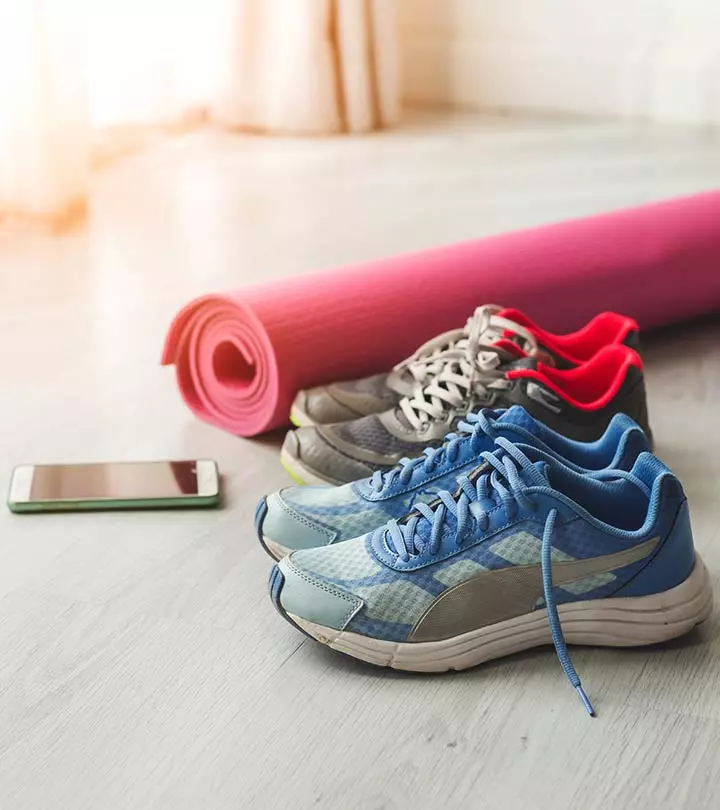

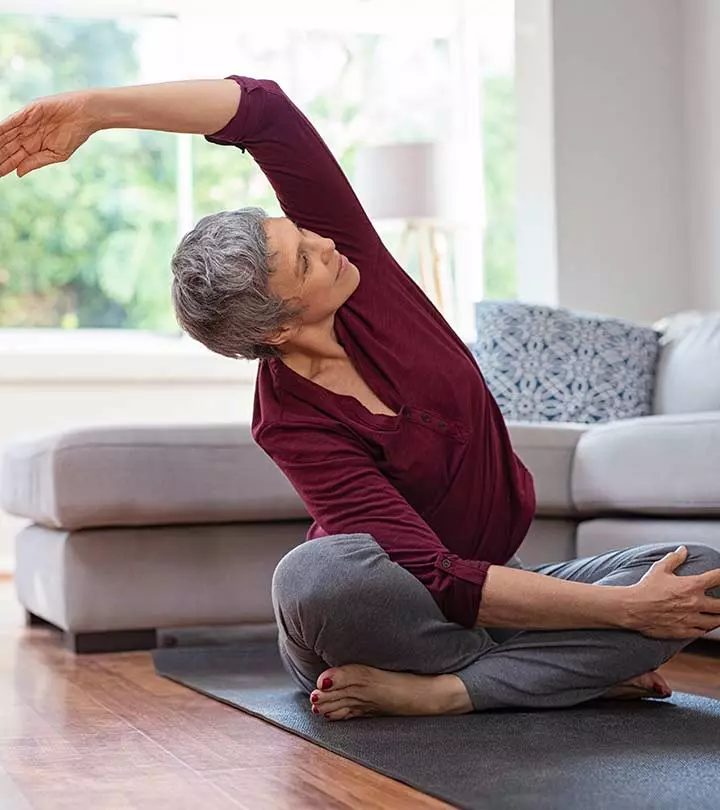
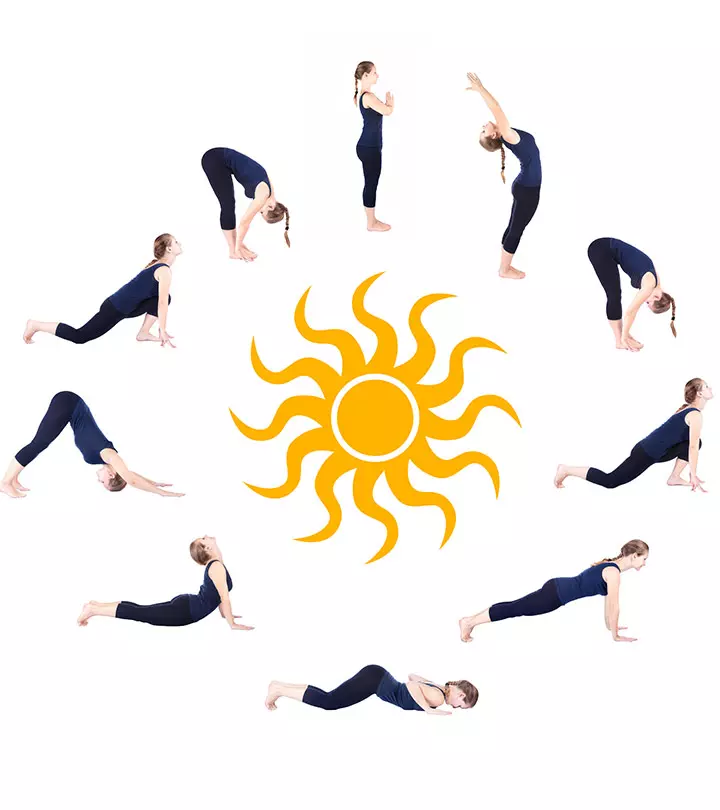


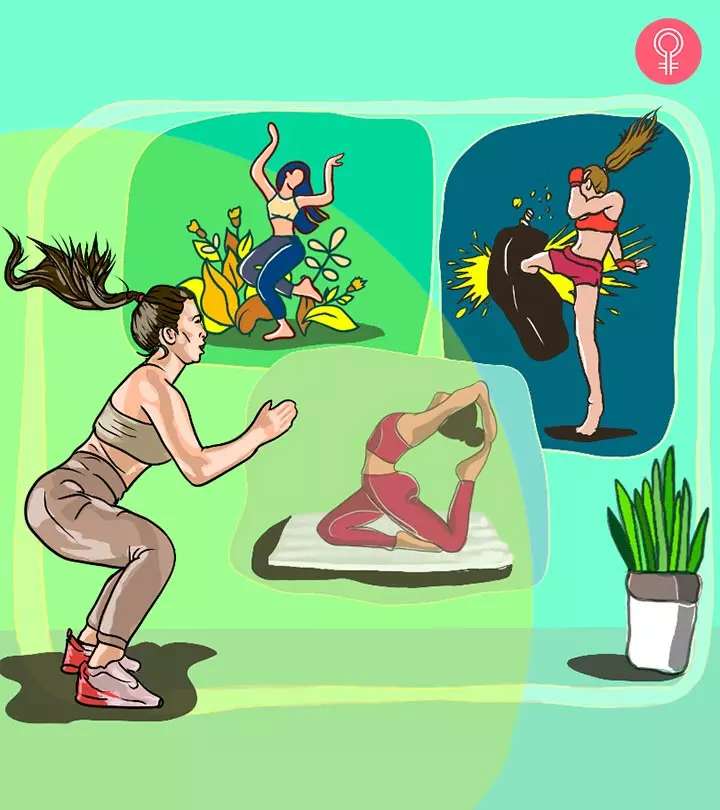


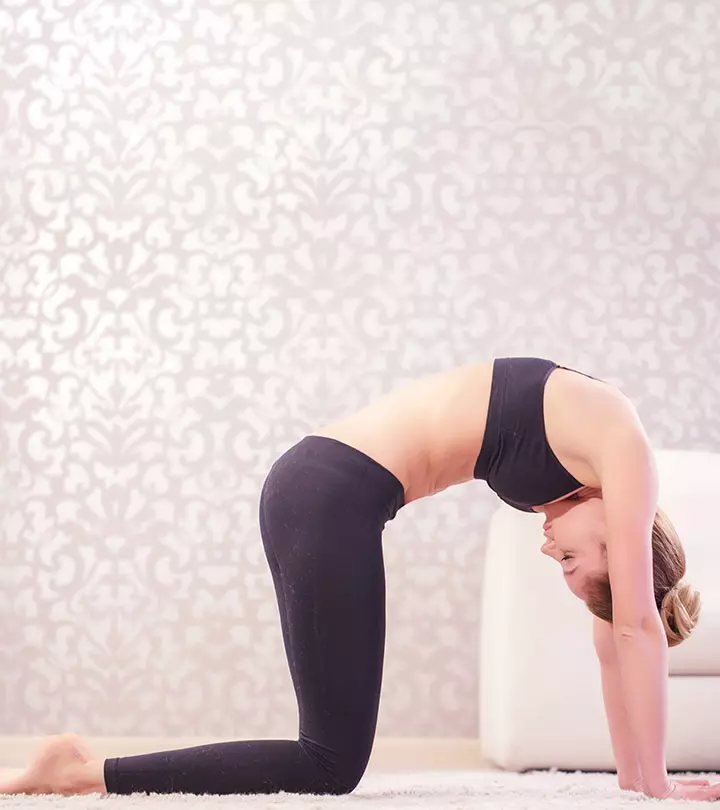
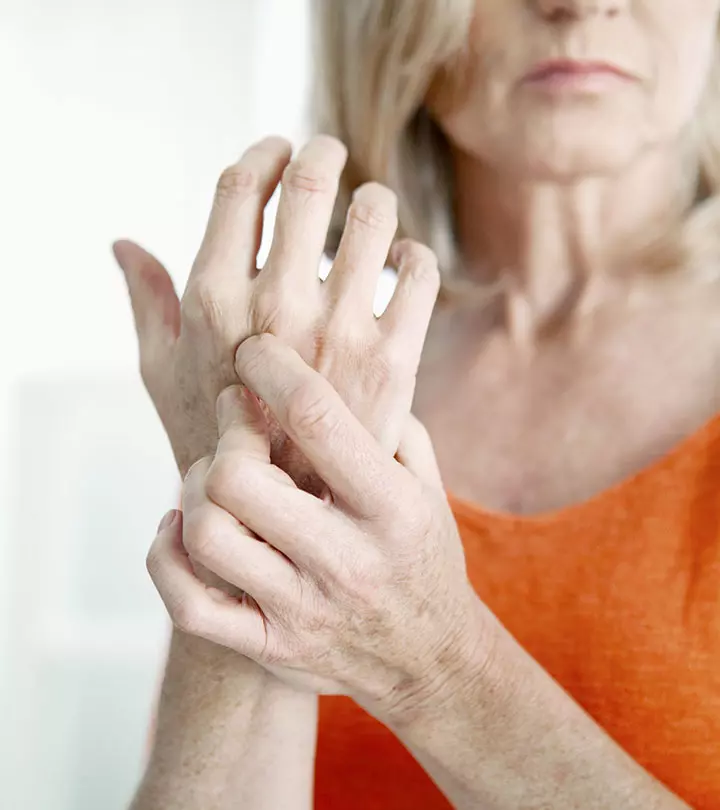



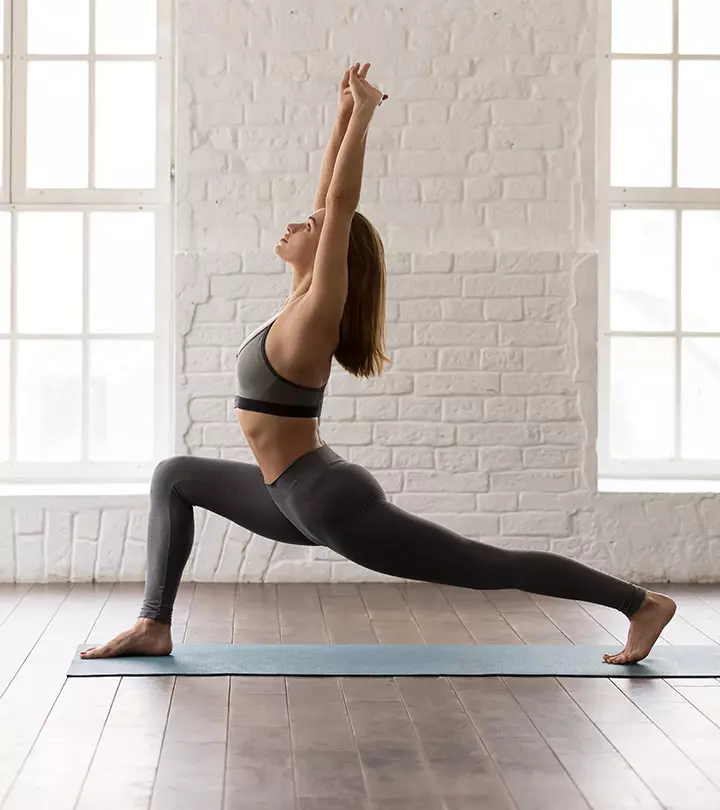



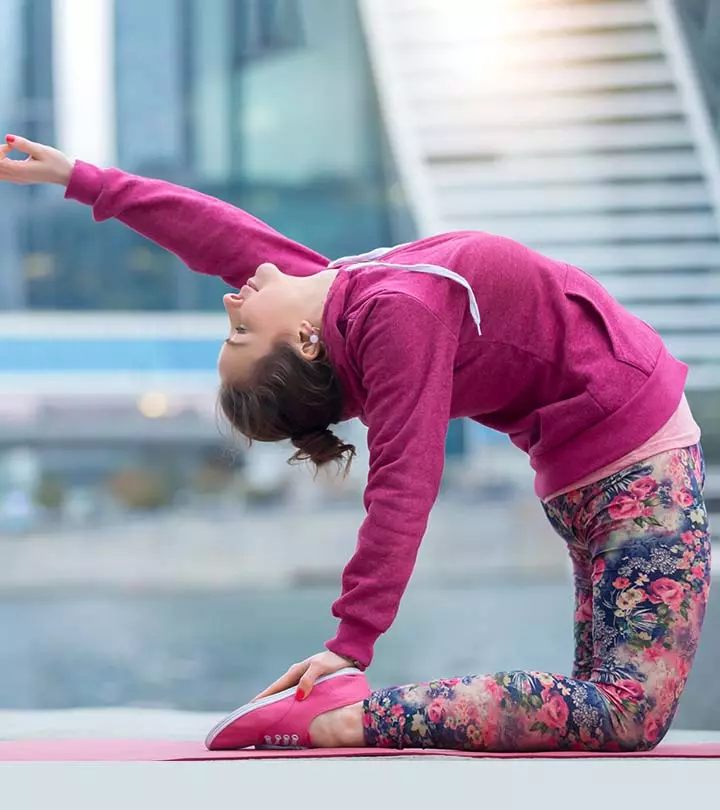

Community Experiences
Join the conversation and become a part of our empowering community! Share your stories, experiences, and insights to connect with other beauty, lifestyle, and health enthusiasts.